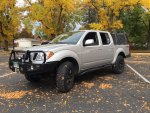You are using an out of date browser. It may not display this or other websites correctly.
You should upgrade or use an alternative browser.
You should upgrade or use an alternative browser.
STT Pro or ST Maxx????
- Thread starter rc51kid
- Start date
RubiconGeoff
Adventurer
I have the S/T Maxx, and they work great on and off road.
I've got the larger 315/70 R17 tires, and they do flat spot over night taking about an eighth to tenth of a mile to "get round" first thing in the morning.
They are very grippy in the rocks for an all terrain. They do chip, and I've got some light slicing in the tread blocks from spinning on sharp rocks.
They also do well on loose rocky trails.
On the street, they are great in heavy rain, do well in snow, and just OK on icy roads.
What surprised me was their composure in the rough twisty canyon roads. I thought they'd be skittish with E rated sidewalls and street pressures (30psi in my case). Instead they are very planted with little side wall roll, considering the height of the side wall, and aggressive tread.
FYI, the 315/70R17 size of the ST-MAXX is a Load Range D, not a Load Range E. It's the same tire I have on my JK:
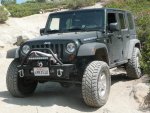
I concur with everything else you've said about these tires. They are great for a daily-driven rig that oftentimes needs a tough tire with an aggressive tread pattern. I am a fairly aggressive driver on twisty roads and I find that the ST-MAXX handles very, very well. So far these are my favorite tires ever, and I've tried a LOT over the years. I don't play in the mud so they are perfect for my needs, but obviously the ST PRO will be much more at home in that particular terrain. For everything else, the ST-MAXX should be equal to or superior than the ST PRO due to its tread pattern. Cooper's 3-ply sidewalls are also known for being among the toughest in the industry, which is why you notice a little bit of flat-spotting on cold mornings. Mind you, the flat-spotting is nothing like an old bias-ply tire, and it goes away in less than a mile. I'll assume the ST PRO has the same behavior since it's built on the same heavy-duty casing.
To clarify the "chipping and slicing" you mentioned, I'll remind you that every tire will see "damage" from rocks and other unforgiving terrain. Most of my trips throughout the Sierra Nevada, Death Valley, and the Nevada desert have been accompanied by my buddy with a similar JKUR with the same-size BFG Mud Terrain KM2. The same trails that left my ST-MAXXs nearly unscathed did this to his BFG's:
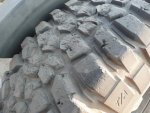
Cooper's high-silica rubber compound is definitely not a gimmick; it really does help resist cutting and chipping, which has always been a known problem with BFG's, which is why one of BFG's primary focuses with their new KO2's is their improved resistance to cutting and chipping. Hopefully their KM3 will be more cut and chip resistant.
Hillbilly Heaven
Explorer
Chipping and chipping over rough terrain should not be a worry unless you are near the EOL of the tire and by then the tire should have been replaced already. You have gotten the good out of it. Now if a tire exhibits chunking or throwing off of tread, that would be a need to be concerned.
RubiconGeoff
Adventurer
Chipping and chipping over rough terrain should not be a worry unless you are near the EOL of the tire and by then the tire should have been replaced already. You have gotten the good out of it. Now if a tire exhibits chunking or throwing off of tread, that would be a need to be concerned.
Agreed. I've never had any problems result from normal offroad wear-and-tear on my tires, but my buddy's tires' disintegration was quite worrisome. I found a pic of one of the first chunks that tore out of his tires:

And a couple more photos of his other shredded tires shortly before he replaced them:
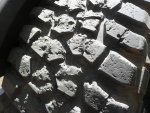
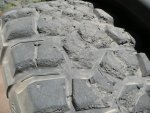
Comanche Scott
Expedition Leader
FYI, the 315/70R17 size of the ST-MAXX is a Load Range D, not a Load Range E. It's the same tire I have on my JK:
View attachment 370994
I concur with everything else you've said about these tires. They are great for a daily-driven rig that oftentimes needs a tough tire with an aggressive tread pattern. I am a fairly aggressive driver on twisty roads and I find that the ST-MAXX handles very, very well. So far these are my favorite tires ever, and I've tried a LOT over the years. I don't play in the mud so they are perfect for my needs, but obviously the ST PRO will be much more at home in that particular terrain. For everything else, the ST-MAXX should be equal to or superior than the ST PRO due to its tread pattern. Cooper's 3-ply sidewalls are also known for being among the toughest in the industry, which is why you notice a little bit of flat-spotting on cold mornings. Mind you, the flat-spotting is nothing like an old bias-ply tire, and it goes away in less than a mile. I'll assume the ST PRO has the same behavior since it's built on the same heavy-duty casing.
To clarify the "chipping and slicing" you mentioned, I'll remind you that every tire will see "damage" from rocks and other unforgiving terrain. Most of my trips throughout the Sierra Nevada, Death Valley, and the Nevada desert have been accompanied by my buddy with a similar JKUR with the same-size BFG Mud Terrain KM2. The same trails that left my ST-MAXXs nearly unscathed did this to his BFG's:
View attachment 370995
Cooper's high-silica rubber compound is definitely not a gimmick; it really does help resist cutting and chipping, which has always been a known problem with BFG's, which is why one of BFG's primary focuses with their new KO2's is their improved resistance to cutting and chipping. Hopefully their KM3 will be more cut and chip resistant.
Thanks for the correction on the load rating!
When running up in the Sierra's rocky trails, what are you airing down to?
Is your driving style more aggressive, or slow and steady on the trail?
So far I've only dropped down to 14psi (stock Rubi wheels), as I really don't want to have to re-seat a bead, or lose a bead on a tough climb. But this Jeep is so easy to go slow with, that I'm thinking I could go to 10psi without worry, as long as I'm careful.
Last edited:
Scott Brady
Founder
I have owned a few sets of both tires. I prefer the MAXX for almost all scenarios. The Pro was of course excellent in mud, but that medium is just not a part of my typical travels.
RubiconGeoff
Adventurer
Thanks for the correction on the load rating!:beer:
When running up in the Sierra's rocky trails, what are you airing down to?
Is your driving style more aggressive, or slow and steady on the trail?
So far I've only dropped down to 14psi (stock Rubi wheels), as I really don't want to have to re-seat a bead, or lose a bead on a tough climb. But this Jeep is so easy to go slow with, that I'm thinking I could go to 10psi without worry, as long as I'm careful.
I'm generally a slow'n'steady driver. I like to let the gearing, suspension, and tires pull me up obstacles rather than hitting them with speed or using lots of wheelspin. I have two sets of Staun Tyre Deflators, one set to "high" pressure (20lbs) for rockcrawling and general purpose offroading, and one set to "low" pressure (15lbs) for sand and snow. I generally don't go any lower than 20psi while rockcrawling because I find that I lose too much ground clearance, and a pointy rock with the Jeep's weight on one tire will almost fully compress the tire; I don't want to risk damaging a rim or cutting a tire by airing down too low. Soft flat surfaces such as sand and snow benefit from the lower pressure however.
The only time I go fast off-road is actually when it is a road: desert 2-tracks and gravel roads. Anyone who's travelled on such terrain knows that the ride smooths out as speeds increase. Plus, throwing up a rooster tail of dust at 70mph while pretending to be Robby Gordon is fun! 20psi allows the tires to take most of the edge off of the rocks and washboards, but is still enough pressure to maintain consistent handling and keep the tires from blowing a bead even while drifting around corners. You can cover a lot more ground in places like Death Valley if you're not afraid to air down and put the suspension to work.
These JKU's are heavy. I used to air my Samurai down to 5lbs and then go down from there as needed. My JK gets aired down to my Samurai's street pressure.
Hillbilly Heaven
Explorer
I'm generally a slow'n'steady driver. I like to let the gearing, suspension, and tires pull me up obstacles rather than hitting them with speed or using lots of wheelspin. I have two sets of Staun Tyre Deflators, one set to "high" pressure (20lbs) for rockcrawling and general purpose offroading, and one set to "low" pressure (15lbs) for sand and snow. I generally don't go any lower than 20psi while rockcrawling because I find that I lose too much ground clearance, and a pointy rock with the Jeep's weight on one tire will almost fully compress the tire; I don't want to risk damaging a rim or cutting a tire by airing down too low. Soft flat surfaces such as sand and snow benefit from the lower pressure however.
The only time I go fast off-road is actually when it is a road: desert 2-tracks and gravel roads. Anyone who's travelled on such terrain knows that the ride smooths out as speeds increase. Plus, throwing up a rooster tail of dust at 70mph while pretending to be Robby Gordon is fun! 20psi allows the tires to take most of the edge off of the rocks and washboards, but is still enough pressure to maintain consistent handling and keep the tires from blowing a bead even while drifting around corners. You can cover a lot more ground in places like Death Valley if you're not afraid to air down and put the suspension to work.
These JKU's are heavy. I used to air my Samurai down to 5lbs and then go down from there as needed. My JK gets aired down to my Samurai's street pressure.I've tried lower pressures in the Jeep, but I really haven't seen any gain in performance except in specific circumstances. For general trail driving, I don't think it's worth the reduced ground clearance since I'm only running 35's and the breakover angle on these LWB Jeeps is their Achilles Heel.
Wonder how you would feel if you also had a set of Stazworks type beadlocks?
I have owned a few sets of both tires. I prefer the MAXX for almost all scenarios. The Pro was of course excellent in mud, but that medium is just not a part of my typical travels.
This is actually very meaningful because you have owned both. Can you tell me, did you own the older STT or the newer STT Pro? Can you give me a idea of what kind of tread life mileage you got from the ST Maxx vs the STT Pro?
Right now i have older BFG KOs. The obviously pack up in mud. Any comparison as to how the ST Maxx does compared to the original KO? Obviously the STT Pro will be better than ether of them.
01tundra
Explorer
The S/T Maxx's currently on my Tacoma have 50,129 miles on them and still have 7/32 of tread left, I will not be replacing them until next Spring. I fully expect to get close to 60k miles out of them, which is great considering I live off of a rough gravel road with a very long, steep, rough gravel driveway that causes wheel spin.
I had Duratrac's on it prior and they were aweful, at 25k miles they were loud and rough. My Cooper's are still relatively quiet and very smooth.
We put Duratracs on my wife's FJ about the same time we put them on my Tacoma, her's got very loud and rough as well. We now have Cooper S/T Maxx's on the FJ and it's smooth and quiet again.
I can easily say that for an all-around tire I've never had a better tire than the S/T Maxx.
I had Duratrac's on it prior and they were aweful, at 25k miles they were loud and rough. My Cooper's are still relatively quiet and very smooth.
We put Duratracs on my wife's FJ about the same time we put them on my Tacoma, her's got very loud and rough as well. We now have Cooper S/T Maxx's on the FJ and it's smooth and quiet again.
I can easily say that for an all-around tire I've never had a better tire than the S/T Maxx.
Last edited:
01tundra
Explorer
Wonder how you would feel if you also had a set of Stazworks type beadlocks?
I had a set of Stazworks on my Tundra, they were built like a tank and awesome off-road......but on the road they were horrible and could not be balanced no matter what tire I tried.....
RubiconGeoff
Adventurer
Wonder how you would feel if you also had a set of Stazworks type beadlocks?
I'm not sure what you mean here. I have no need for beadlocks; in my 24 years of offroading, the only time I've ever blown a bead is when a sidewall got sliced and the tire went completely flat.
Scott Brady
Founder
This is actually very meaningful because you have owned both. Can you tell me, did you own the older STT or the newer STT Pro? Can you give me a idea of what kind of tread life mileage you got from the ST Maxx vs the STT Pro?
Right now i have older BFG KOs. The obviously pack up in mud. Any comparison as to how the ST Maxx does compared to the original KO? Obviously the STT Pro will be better than ether of them.
We have the new STT Pro, originally on my G-Wagen and now on our CFO's Tundra. My experience has been that the Maxx is superior to the original KO for the traveling I do in North America, which is a high-percentage of dirt and technical terrain. The lug integrity alone is a reason to use the Maxx over the older KOs.

SilicaRich
Wandering Inverted
The S/T Maxx's currently on my Tacoma have 50,129 miles on them and still have 7/32 of tread left, I will not be replacing them until next Spring.
Holy ****! Does Cooper put iron in their tire compounds because that's insanely awesome. Theoretically speaking, you could get around 85k miles out of them until they are bald
Similar threads
- Replies
- 7
- Views
- 2K
- Replies
- 2
- Views
- 2K
- Replies
- 3
- Views
- 2K

